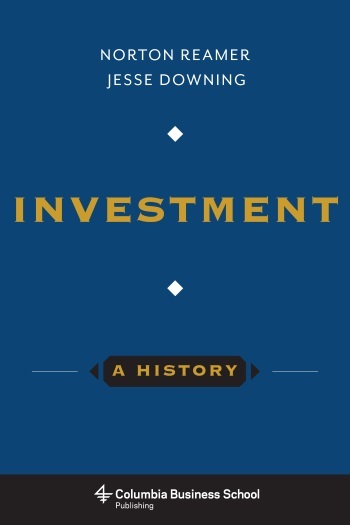A conversation with Norton Reamer and Jesse Downing, authors of "Investment: A History"
“[T]he basic principles of investing are timeless, even as the economic and social stakes grow higher. The challenge will be to harness all that increasing sophistication to further push the democratization of investment, and in that regard we are optimists.” — Norton Reamer and Jesse Downing
This week, our featured book is Investment: A History, by Norton Reamer and Jesse Downing. In the first post of the week’s feature, we are happy to present an interview with Reamer and Downing in which they discuss their goals for the book, important changes in the history of investing, and what the future holds for investors.
Don’t forget to enter our book giveaway for a chance to win a free copy of Investment: A History! You can also learn more about the book and its authors on the Investment: A History webpage and Youtube channel!
What will readers find in Investment: A History?
The book explains key elements in the long history of investment. Each chapter includes important stories and lessons that are intended to illustrate crucial dimensions of the investment world, as they have developed over the centuries. Our goal is to increase understanding of the investment practices and opportunities of today by understanding the history of investing.
In broad scope, what are the most important findings in the book?
Most people will be surprised to find out how remarkably uncomplicated it is to be a sensible investor, and in that regard we identified four basic investing principles. First, look at every investment as “real.” That is, when you invest, you own the underlying asset—e.g., with stocks you are buying a piece of a corporation. Don’t be distracted by the paper form of the investment. Understand the basics of whatever entity you are buying.
Second, it’s all about fundamental value, where “value” is determined by the value today of future cash flows that the investment may produce over its lifetime. Third, intelligent use of financial leverage is a legitimate tool for investors; in fact, it has helped build most of the great fortunes of history. Of course, excessive leverage can be extremely dangerous because all leverage will multiply returns—either positively or negatively. Finally, the most basic management skill is resource allocation: i.e., the effective allocation of capital and human resources.
Investing did not always exist in its current form. What were the precursors to the current investment landscape?
With ancient and pre-modern investment, we emphasize three areas: the basic investment vehicles of early history; the extreme inequality in the distribution of investment opportunity and benefit; and the surprising sophistication of some early investment vehicles, strategies, and purposes.
We believe that, to grasp the reality and significance of investment as a fundamental human activity, it’s necessary to begin in ancient times and understand the roles of agricultural land, lending and trade in the ancient world. At the same time, it is important to acknowledge that by today’s standards, it took an astonishing amount of wealth and power to even qualify to be an ‘investor.’ Finally, we felt it was essential to understand that in some respects—despite a lack of investment diversity and the absence of equality—investment even in those early days had features that were remarkably sophisticated and prescient.
How has investing changed over time?
Although most people today don’t seem to regard investment or even capitalism as very democratic or egalitarian, in fact a dramatic democratic transition occurred from the 17th to 19th centuries. This transition was facilitated by the advent of joint stock companies and public markets, combined with the Industrial Revolution. In subsequent centuries, we have benefited from broad diversification of investment opportunities, limited liability, and public availability—not to mention accumulated savings in the hands of the common man, allowing many more of us to take advantage of those opportunities. The effect has been dramatic, even though there is a lot more to be accomplished. The democratization of investment is one of the greatest economic changes in history, and there is a lot to be learned from understanding it.
Can you give an example the kinds of change you are talking about?
The concept and funding of retirement were radical and new as recently as 150 years ago. This struggle to provide for old age and infirmity and to support well-earned leisure for the “common man” is interesting and important. Today we all take for granted a wide range of public and private retirement benefits, but in order to succeed, this new thing called “retirement” needed to be funded in some way. Building those funding structures was difficult and controversial, and the debate continues to this day. Tracing that history is very instructive.
As investment underwent a “democratization,” what kinds of new opportunities emerged?
Beginning in the eighteenth century, new forms of investments began to emerge, as well as new types of investors who were not members of the socioeconomic elite. The needs of these new investors were met by life insurance, savings accounts, investment advisory relationships, and mutual funds. These developments represented a new form of economic freedom, one previously unavailable to the vast majority of people throughout history. This new freedom was supported by expanding the types of vehicles available to help these investors put their accumulated surpluses to work. These investors and instruments made up the core of 19th and 20th century investing and continue to this day to be the mainstays of individual and institutional investors. Understanding these elements of the investment world is essential to grasping the possibilities and challenges of investment for and by everyman.
In addition, the last 40 years have brought dramatic advances in investment vehicles and improved access to desirable outcomes for investors. This includes a whole range of investment alternatives (e.g., hedge funds, private equity investments, real estate funds, etc.) in addition to simple “passive” investments like index funds and Exchange Traded Funds. This blizzard of new investment choices has arrived with dramatic force, affecting sophisticated and unsophisticated investors alike.
But in this new world of investing all participants are not equal—why is that and is it changing?
As assets under management in the investing business skyrocketed over the past several decades, so did the financial rewards to professional investors of independence and innovation. Rewards to some investment professionals—whom we might call the ‘New Elite’—are mind-boggling, while superior performance is far from assured. This evolution of a New Elite has raised questions concerning efficiency and fairness. Today investment is more democratic, but it’s not yet equal. The common man lacks access to many of the alternative strategies available to elite investors—i.e., the wealthy and large institutions. At the same time, some investing professionals have used modern investment theory to create low-cost alternatives. So, even though money is often managed by the elite, most of that money is being managed on behalf of the common man via retirement plans, foundations, endowments, and sovereign wealth funds. Indexed mutual funds are a good example of how the average investor can obtain professional investment management services in a low-cost, highly accessible investment vehicle.
So what does the future hold?
The aggregation of assets—and increasing sophistication of investment practice—makes investing a very lucrative and specialized field for the elite. And the tremendous scale of assets under management today, versus only a few decades ago, has raised a range of issues related to fees, profitability, efficiency, performance effectiveness, and public and social issues. Yet the basic principles of investing are timeless, even as the economic and social stakes grow higher. The challenge will be to harness all that increasing sophistication to further push the democratization of investment, and in that regard we are optimists.






